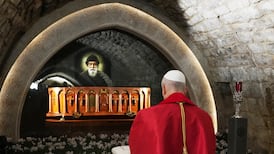Syrian Red Crescent ambulances began emergency evacuations of seriously ill children and adults on Wednesday from the besieged rebel and jihadi stronghold of eastern Ghouta after arrangements were approved by Syrian president Bashar al-Assad.
A total of 29 critically ill patients were set to be taken for treatment to hospitals in Damascus.
Among the first to leave were a girl with haemophilia, a boy with an autoimmune disorder, a child with leukaemia and a man requiring a kidney transplant. Other cases include 18 children and four women.
The chief jihadi group in the area, Saudi Arabia-sponsored Jaish al-Islam, said the government had agreed to evacuations in exchange for the release of 29 prisoners.
Red Cross regional director Robert Mardini said he was "encouraged to see the beginning of a life-saving operation". The Syrian Arab Red Crescent said the evacuations were a result of "long negotiations".
The head of the United Nations humanitarian taskforce for Syria, Jan Egeland, said last week that 16 people had died while waiting for the process to begin. He said nearly 500 were on a list of people needing urgent medical treatment but were trapped in the enclave. There would be "more deaths unless we get evacuation going", he said.
Jihadi bastion
A region consisting of towns, villages and countryside abutting Damascus, eastern Ghouta has been a bastion of jihadi factions for the past three years. Once the main market garden of the capital, eastern Ghouta has been under tightening siege over the past six weeks following an attempt in mid-November by three factions – Ahrar al-Sham, Faylaq al-Rahman and al-Qaeda’s Tahrir al-Sham (led by Jabhat Fatah al-Sham) – to mount an attack into Damascus.
The offensive was repulsed and the Syrian military responded with air bombardments and artillery attacks that, reportedly, killed many civilians.
The jihadis have retaliated by lobbing mortars into Damascus Old City, targeting the Bab al-Sharqi (Eastern Gate) and Bab Touma (StThomas Gate) quarters where many Christians live. Several dozen civilians have been killed and wounded in these attacks and considerable material damage has been inflicted.
Until the jihadi offensive, eastern Ghouta had been relatively quiet. In May it was declared one of four “de-confliction”, or ceasefire, zones under the Russian, Turkish and Iranian plan to gradually reduce conflict across the country. However, the three factions involved in the offensive rejected “de-confliction” and prepared for their bid to break out of the siege.
Problems escalated after the eastern suburbs of Qaboun, Jobar and Barzeh had fallen to the Syrian army and opposition fighters and families had been transported to the insurgent-held northwestern province of Idlib. Tunnels used for movement of fighters and smuggling arms into eastern Ghouta were destroyed, also cutting off underground deliveries of medical and food supplies.
As a result hunger and malnutrition increased, threatening the lives of 400,000 people who are said to live in eastern Ghouta, where local produce can no longer meet the needs of residents.
The collapse of jihadi defences in the three strategic quarters followed two months of fierce inter-factional fighting between Jaish al-Islam and Tahrir al-Sham/Ahrar al-Sham.
The capital remains under threat from eastern Ghouta and the town of Harasta, northeast of Damascus and Islamic State-held Yarmouk, south of the city.
The Syrian army, backed by Russian air power and militia allies, has systematically cleared of insurgents the northern, western and southwestern approaches to the city and re-established control.
Between 300,000 and 340,000 people have been killed and 11 million driven from their homes since war erupted in 2011.











